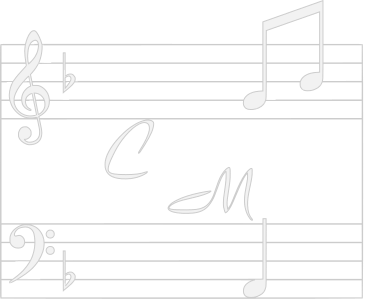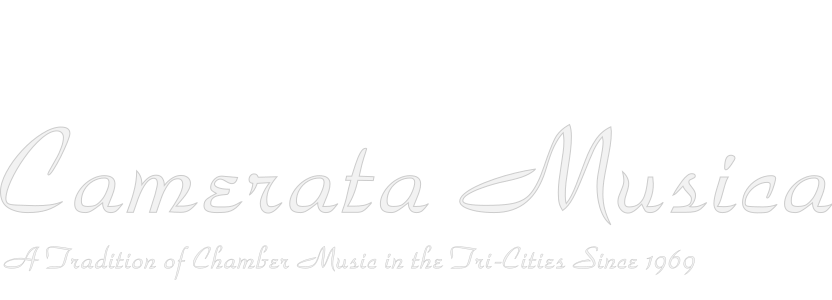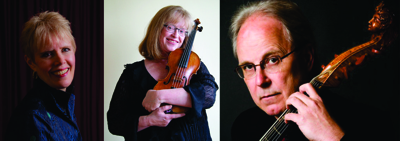Sat., March 28, 2015
March 28, 2015 8:00pm at Battelle Auditorium
Linda Melsted, violin
John Dornenburg, viola da gamba
Jillon Stoppels Dupree, harpsichord
| Trio Sonata III in A minor, Opus 1, no.3 | Dietrich Buxtehude (1637-1707) |
| Adagio | |
| Allegro | |
| Lento - Vivace - Largo | |
| Presto - Lento | |
| Suite in A minor, Op. 3, no. 10, for solo viol | Carolus Hacquart (ca. 1640-1701) |
| Preludium: Lente - Vivace - Grave | |
| Sarabande: Variatio | |
| Gigue | |
| Trio Sonata III in G minor, Opus 2, no.3 | Dietrich Buxtehude | Vivace – Lento – Allegro – Andante – Grave - Gigue |
| Sonata III in A major, (1694) | Philipp Heinrich Erlebach (1657-1714) |
| Adagio – Allegro - Lento | |
| Allemande | |
| Courante | |
| Sarabande | |
| Ciaconne | |
| Final: Adagio |
Intermission
|
| Sonata Prima in C major, for solo violin and basso continuo from Sonatae Unarum Fidium, 1664 |
Johann Heinrich Schmelzer (ca. 1620-1680) |
| Arietta and Variations in F major, P.29, for solo keyboard | Johann Pachelbel (1653-1706) |
| Trio Sonata IV in B-flat major, Opus 1, no.4 | Dietrich Buxtehude |
| Vivace – Allegro/Presto | |
| Lento – Allegro/Vivace |
Buxtehude: The Fantastic Style
Dietrich Buxtehude was one of the most ingenious proponents of the Stylus Fantasticus, or the Fantastic Style. The root of this style of baroque music lies in the early Italian instrumental music of the first decades of the 17th century. Free improvisation was an important element, and often ground basses (repeated bass patterns) were used for these elaborate, amazing improvisations. The most famous chordal pattern is that of the Chaconne or Passacaglia, with its four descending notes. Sonatas in the Fantastic Style are characterized by a free form and short, contrasting movements that flow from one to another. Many German composers, studying in Italy, became particularly enamored of this style, so much so that by the second half of the 17th century the Fantastic Style became associated mostly with German music. The music explores all the musical affects, or emotional expressions: from virtuosic fireworks to soulful melodies to rich, chromatic harmonies, showing off the extremes of expressivity on all the instruments. This represents some of the most beautiful repertoire ever written for strings and basso continuo.
Artiest Bio
Described as “one of the most outstanding early musicians in North America” (IONARTS) and “a baroque star” (Seattle Times), harpsichordist Jillon Stoppels Dupree has captivated audiences in cities ranging from London to Amsterdam to New York. Her world premiere recording of Philip Glass’s Concerto for Harpsichord and Chamber Orchestra with the Northwest Chamber Orchestra (heralded as “superb” by the New York Times) was released to high acclaim in fall of 2006 on the Orange Mountain Music label. Her playing can also be heard on the Meridian, Wild Boar, Decca and Delos record labels, and she has appeared live on BBC England, Polish National Television, CBS Television and National Public Radio.
Ms. Dupree has been a featured artist at the highly-respected early music festivals of York (England), Boston and Berkeley, as well as at the National Music Museum, the Cleveland and Santa Barbara Museums of Art, and numerous universities and colleges. Her chamber music collaborations include performances with violinists Ingrid Matthews, Stanley Ritchie and Jaap Schröder; violists da gamba Wieland Kuijken and Margriet Tindemans; singers Julianne Baird, Ellen Hargis and Ann Monoyios; and recorder virtuosi Marion Verbruggen, Eva Legene and Vicki Boeckman. She is currently the harpsichordist with Magnificat Baroque Ensemble, based in the San Francisco Bay area, as well as with the Seattle Symphony. Recent activities include a residency at Stanford University, a performance at the Bloomington Early Music Festival, participation in the Gustav Leonhardt Tribute recital at the Berkeley Early Music Festival, and a solo Bach recording project.
A recipient of a Fulbright Fellowship and the National Endowment for the Arts Solo Recitalists grant, Ms. Dupree has taught at the Oberlin College Conservatory of Music, the University of Washington, and the University of Michigan. She is currently on the early music faculty at Seattle’s Cornish College of the Arts and is the founding director of the Gallery Concerts early music series in Seattle.
John Dornenburg is a San Francisco Bay Area performer, teacher, and recording artist. He performs on all sizes of viola da gamba and has been featured on more than 30 CD recordings. His two most recent CDs feature virtuoso music for unaccompanied viola da gamba by Schenck, Abel, Sainte-Colombe, Kühnel, Simpson, Hacquart, and Hume, and he has also recorded solo music by more familiar Baroque composers such as J.S. Bach, Telemann, Marais, and Handel. John has appeared as soloist at major festivals in the British Isles, Poland, Turkey, Lebanon, Australia, New Zealand, and Holland, and at both the Oregon and Carmel Bach Festivals in the U.S.A. He is director of the Sex Chordae Consort of Viols, co-director of the Archetti Baroque String Ensemble, and co-founder of the Baroque ensemble Music’s Re-creation. In the Bay Area he also performs regularly with Magnificat, and, on occasion, with Philharmonia Baroque Orchestra, American Bach Soloists, Jubilate Orchestra, and many others. He studied with Nikolaus Harnoncourt at the Mozarteum in Salzburg and with Wieland Kuijken in The Hague, where he was awarded the Soloist’s Diploma. John is Lecturer in viola da gamba at Stanford University, Instructor of violone at UC Berkeley, and Faculty Emeritus in music history at CSU, Sacramento.
The passionate artistry of violinist Linda Melsted has won the hearts of audiences across North America, Europe, and Japan. She has appeared as soloist, member, and leader of many outstanding ensembles including Tafelmusik Baroque Orchestra, Freiburg Baroque Orchestra, Portland Baroque Orchestra, Seattle Baroque Orchestra, Pacific Baroque Orchestra, and Pacific Music Works. Linda is the featured soloist in Tafelmusik’s TV documentary, DVD and CD “Le Mozart Noir,” where she musically incarnates the remarkable 18th-century virtuoso and adventurer, the Chevalier de Saint-Georges. An active chamber musician, Linda has appeared on many series including Early Music Vancouver, Gallery Concerts, Primavera Concerts, Bloomington Early Music Festival, the Calgary Symphony’s Italian Music Festival, Folia, Toronto Music Garden, Quadra Island Discovery Chamber Music Festival, and Tactus.
Linda was a member of Tafelmusik 1992-2004, Music Director of Nota Bene Baroque Orchestra, 2005-2009, a regular guest leader and soloist of the Kitchener-Waterloo Symphony Orchestra’s “Baroque and Beyond” series, and taught violin at the University of Waterloo. Happily back in Seattle since 2010, she has formed the Salish Sea Players, a group dedicated to performing chamber music in retirement and nursing facilities, and is the Director of Seattle’s community Baroque orchestra, the New Baroque Orchestra. This past spring, 2013, she was thrilled to perform in the first Baroque chamber music concert in Hamilton, Montana. Linda performs on a Nicolo Amati violin from 1670.


